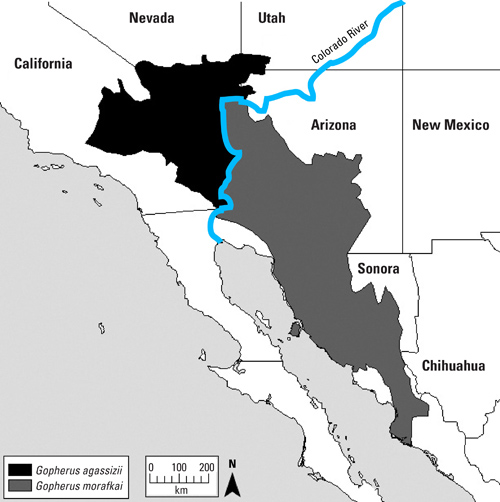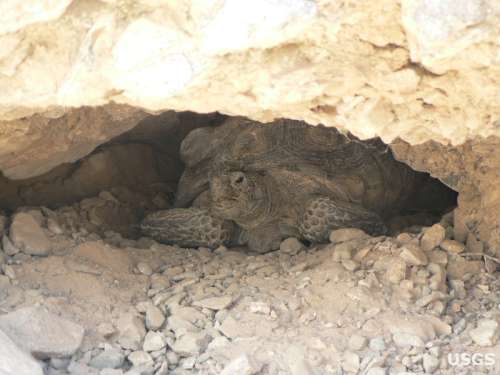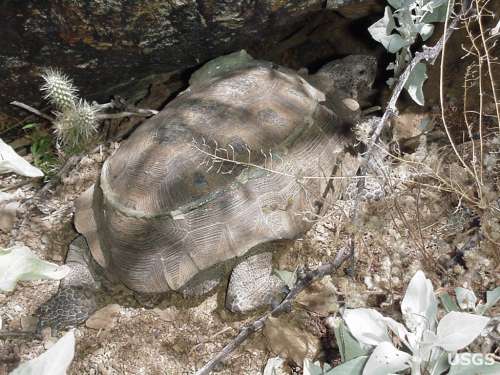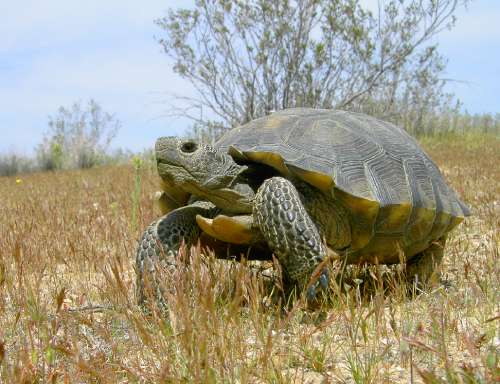RIVERSIDE, Calif. – A new study shows that the desert tortoise, thought to be one species for the past 150 years, now includes two separate and distinct species, based on DNA evidence and biological and geographical distinctions.
This genetic evidence confirms previous suspicions, based on life history analysis, that tortoises west and east of the Colorado River are two separate species.
The newly recognized species has been named Morafka’s desert tortoise (Gopherus morafkai) and represents populations naturally found east and south of the Colorado River, from Arizona extending into Mexico.
The originally recognized species, the Agassiz’s desert tortoise (Gopherus agassizii) is listed as threatened under the federal Endangered Species Act. It represents populations naturally found west and north of the Colorado River in Utah, Nevada, northern Arizona and California.

Map showing the range of both the Morafka’s desert tortoise (Gopherus morafkai) and the Agassiz’s desert tortoise (Gopherus agassizii). Image credit: USGS
The U.S. Fish and Wildlife Service (FWS), which manages the recovery of threatened and endangered species, had already been treating tortoises on each side of the Colorado River as distinct populations The genetic evidence simply backs up previous observations, such as differences in life history and reproductive strategies.
“The two species have different habitat preferences,” says Kristin Berry, a USGS biologist who has studied desert tortoise biology for more than 40 years and a coauthor on the study. “Morafka’s tortoise prefers to hide and burrow under rock crevices on steep, rocky hillsides, while the Agassiz’s tortoise prefers to dig burrows in valleys.”

An Agassiz's desert tortoise hides in a burrow; a radio transmitter is attached to its shell as part of a USGS study. Image credit: Steven Schwarzbach, USGS
Roy Averill-Murray, the desert tortoise recovery coordinator for the Fish and Wildlife Service said, “We appreciate the efforts of USGS and other researchers to increase our scientific knowledge about the taxonomy of the desert tortoise. The study’s finding that the Morafka’s desert tortoise is a new species confirms the Service’s decision to evaluate this population independently from the Agassiz’s desert tortoise, and will not change the status of either species under the Endangered Species Act or change existing recovery plans.”
Distinguishing the two species required some historical detective work by the researchers. Desert tortoises were first described in 1861 by an Army physician, J.G. Cooper. But two of the original specimens were lost, possibly as a result of the San Francisco earthquake and fire of 1906. Fortunately, Cooper had sent a third specimen to the Smithsonian — and its DNA helped researchers in their analysis 150 years later.

A Morafka's desert tortoise in Saguaro National Park, with radio transmitter attached to its shell as part of a USGS study. Image credit: Jeff Lovich, USGS
The study is published in the journal ZooKeys and authored by Robert Murphy of the Royal Ontario Museum in Canada, Kristin Berry of the USGS, and colleagues from University of Arizona, California Academy of Sciences and Lincoln University (Mo.).
Field research and travel for this study was supported by contracts from University of California Los Angeles, California State University Dominguez Hills, US Army Fort Irwin, USAF Edwards Air Force Base, USMC Air Ground Combat Center Twentynine Palms, California Department of Fish and Game, the Bureau of Land Management and the USGS.

Mojave Desert Tortoise found in Piute Valley in Clark County, Nevada, in 2005. Image credit: Ken Nussear, U.S. Geological Survey
Read a detailed FAQ about the study on the USGS Western Ecological Center webpage.
More information on desert tortoise research by USGS biologist Kristin Berry: https://www.werc.usgs.gov/boxsprings
Table comparison that distinguishes the Morafka’s desert tortoise (Gopherus morafkai) from the Agassiz’s desert tortoise (Gopherus agassizii).
| Agassiz’s desert tortoise Gopherus agassizii (Cooper 1861) | Morafka’s desert tortoise (new species) Gopherus morafkai Murphy et al. 2011 | |
| Geographical Distribution | North and west of Colorado River | South and east of Colorado River |
| General Shape of Shell | Box-like, high domed in CA Box-like, low-domed in UT | Flatter, pear-shaped |
| Preferred Topography | Predominantly in valleys; digs and hides in burrows | Predominantly on slopes and rocky hillsides; hides and burrows under rock crevices |
| Preferred Habitats | Mostly in Mojave Desert, around salbrush scrub, creosote bush scrub, desert scrub, tree yucca woodland | Mostly in Sonoran Desert, around uplands, thornscrub and grasslands |
| Egg Laying Season | April to mid-July | Early June to early August |
| Federal Status | Threatened | Not yet listed |
| Namesake | Louis Agassiz, eminent 19th Century biologist and Harvard professor | David J. Morafka, late distinguished biologist and California State University Dominguez Hills professor |
*Source: U.S. Geological Survey
